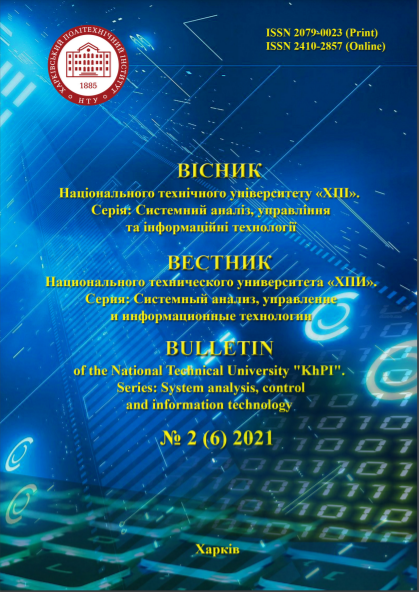INFORMATION TECHNOLOGY OF FORMING OPTION FOR LOGISTICS DISTRIBUTION CHANNEL CONFIGURATION RESISTANT TO EMERGENCIES
DOI:
https://doi.org/10.20998/2079-0023.2021.02.14Keywords:
strategic management, logistic system configuration option, service level, emergency situation, minimax criterion, service-oriented architectureAbstract
The problem and the main stages of choosing a rational configuration of a four-level logistics network that is resistant to the impact of emergencies for
strategic planning are considered. The problem under consideration belongs to the class of multicriteria optimization problems. Criteria related to the
financial costs of building and operating a logistics distribution channel, as well as criteria related to the level of quality of customer service, are
contradictory. To solve the problem of stability of the logistics system configuration to emergencies, such as failure of intermediate warehouses,
failure of transport arteries, etc., a strategic management information system was developed by integrating existing software components at the level of
enterprise software applications. The integration of the system was based on a service-oriented architecture, as all its components are heterogeneous in
nature. This approach allows you to reuse existing program code. To determine a sustainable configuration option, two criteria are used, which are
considered equivalent: the level of costs for the maintenance of the logistics channel and the level of service quality in the event of different
emergencies. Since the probability of emergencies is unknown, the minimax criterion is used to minimize the risk when choosing a rational
configuration of the logistics network. For this purpose, losses from emergencies are calculated according to all criteria, and there is a variant of the
logistics network configuration that will be the least risky. That is, we will not be able to get a worse result than the one we rely on. The results of the
study are presented in the form of a configuration variant of the logistics distribution system, which can be used in the future to determine business
options.
References
Godlevskyi M. D., Stankevich A. A., Godlevskyi I. M. Tekhnologiya formirovaniya sistemy organizatsionnogo upravleniya logistikoy distribyutsii pri strategicheskom planirovanii [Distribution logistic organizational management system technology formation with strategic planning]. Vostochno-Evropeyskiy zhurnal peredovykh tekhnologiy [Eastern-European Journal of Enterprise Technologies]. 2012, no. 4/3 (58), pp. 17–21.
Powers, Richard F. Optimization Models For Logistics Decisions. Journal of Business Logistics. 1989, vol. 10, issue 1, pp. 106–121.
Bartolacci M., LeBlanc L., Kayikci Y., Grossman T. Optimization Modeling for Logistics: Options and Implementations. Journal of Business Logistics. 2012, vol. 33, iss. 2, pp. 118–127.
Silva J., Hernandez L., Crissien T., Bonerge O., Lezama P., Portillo R. Model and Simulation of a Distribution Logistic System for Learning. Procedia Computer Science. 2019, vol. 160, pp. 635–640.
Demare T., Bertelle C., Dutot A., Leveque L. Modeling logistic systems with an agent-based model and dynamic graphs. Journal of Transport Geography. 2017, vol. 62, pp. 51–65.
Godlevskyi I. M., Hiievskyi D. O. Tekhnolohiia bahatokryterialnoho syntezu ta vyboru rozpodilenoi orhanizatsiinoi struktury upravlinnia lohistychnoiu systemoiu dystrybutsii [Technology of multiplecriteria synthesis and choise of distributed organizational management structure of distribution logistics system]. Visnyk Natsionalnoho tekhnichnoho universytetu “KhPI” [Bulletin of the National Technical University "KhPI"]. Kharkiv, NTU “KhPI” Publ., 2017, no. 55, pp. 72–76.
Zak J. The methodology of multiple criteria decision making/aiding in public transportation. Journal Advanced Transportation. 2010, vol. 45, pp. 1–20. doi: 10.1002/atr.108.
Godlevskyi I. M. Modeli, metody ta informatsiina tekhnolohiia syntezu orhanizatsiinoi struktury systemy upravlinnia lohistykoiu dystrybutsii: dis. ... kand. tekhn. nauk [Models, methods and information technology synthesis of the organizational structure of the logistics distribution management system. Candidate eng. sci. diss. (Ph. D.)]. Kharkiv, 2020. 176 p.
Godlevskyi I. M., Turevych M. D., Medvediev V. V. Informatsiina tekhnolohiia formuvannia variantiv konfihuratsii lohistychnoho kanalu dystrybutsii [Information technology forming options for logistics distribution channel configuration]. Suchasni informatsiini systemy [Advanced Information Systems]. 2020, vol. 4, no. 1, pp. 63–70.
Muschick E., Muller P. Entscheidungspraxis. Berlin, VEB Verlag Technik, 1987. 142 p. (Russ. ed.: Muschick E., Muller P. Metody prinyatiya tekhnicheskikh resheniy. Moscov, Mir Publ., 1980. 208 p.).
Fowler M. Patterns of Enterprise Application architecture. Boston, Addison-Wesley, 2003. 559 p.
Saaty T. Transport Planning with Multiple Criteria: The Analytic Hierarchy Process Applications and Progress Review. Journal of Advanced Transportation. 1995, vol. 29(1), pp. 81–126.
Downloads
Published
How to Cite
Issue
Section
License
LicenseAuthors who publish with this journal agree to the following terms:
- Authors retain copyright and grant the journal right of first publication with the work simultaneously licensed under a Creative Commons Attribution License that allows others to share the work with an acknowledgement of the work's authorship and initial publication in this journal.
- Authors are able to enter into separate, additional contractual arrangements for the non-exclusive distribution of the journal's published version of the work (e.g., post it to an institutional repository or publish it in a book), with an acknowledgement of its initial publication in this journal.
- Authors are permitted and encouraged to post their work online (e.g., in institutional repositories or on their website) prior to and during the submission process, as it can lead to productive exchanges, as well as earlier and greater citation of published work (See The Effect of Open Access).


